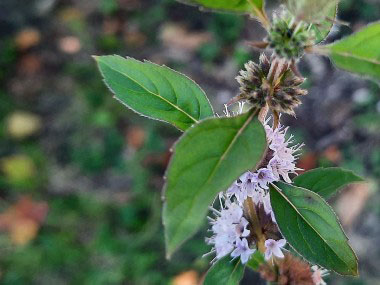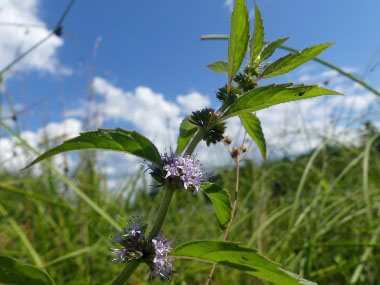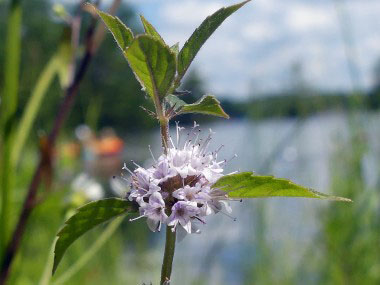





To support our efforts please browse our store (books with health benefits, etc.).
Corn mint is a perennial plant that is considered the wild sister of peppermint. This plant is in the the mint (Lamiaceae) family. The natural habitat of corn mint includes temperate areas of North America, Europe, the Middle East, and Asia. Corn mint is aromatic and like other mints, it is used to help relieve indigestion and to ehlp alleviate colds. It is well known for its antiseptic properties and its beneficial effect on digestion. The plant was once commonly used as an insect repellent. Rats and mice dislike the smell of mint so it was commonly used in homes. The leaves also repel various insects. Corn mint is also known as field mint, wild mint, Chinese Mint, Japanese field mint, and Japanese mint.
Distinguishing Features
This mint is an herbaceous plant with a creeping rootstock from which grow erect or semi-sprawling squarish stems. The leaves grow opposite and have serrated margin. The flowers occur in whorls on the stem at the leaf axils.
Flowers
Clusters of about 20 flowers form around the leaf axils along much of the plant, blooming from the bottom of the plant up. Individual flowers are about 4mm (0.16") long and tubular. The upper lip is notched into 2 parts, the lower lip has 3 equal sized lobes. Each flower has 4 long stamens. Flowers range from pink to pale lavender to almost white, with darker spots on the inside of the tube. They bloom from June to September depending on location. The corn mint calyx is about a third as long as the flower, and is hairy with short, triangular lobes.
 Fields
of Nutrition has medicinal benefits and vitamin/mineral content of Corn Mint.
Fields
of Nutrition has medicinal benefits and vitamin/mineral content of Corn Mint.
Leaves
Leaves are opposite with pairs at right angles to those above and below it. Leaf blade is ovate to elliptic, with blunt or quite tapered tip, with tapered base, and the margins are serrated. Leaves measure up to 6cm (2½") long and 2.5cm (1") wide. Corn mint leaves are strongly aromatic when crushed.
Height
Corn mint grows 10 to 30cm (4 to 12"). The 4-edged squared stem is erect, ascending, unbranched to branching, hairy, and it is often reddish.
Habitat
This mint grows in moist places; along shorelines, stream banks, in wet meadows, and in ditches. It can also be found in fields but it thrives in moist, nitrogenous, sandy-loamy or humus-clay soils.
Edible Parts
Leaves are used as a flavouring in salads or in cooked foods. A soothing herbal tea is made from fresh or dried leaves.
Other Name
Wild Mint.
Similar Plants
Winter Survival Food Handbook

PDF Plant Magazines
Types of Wild Food
Geographic Zones Seasons
Disclaimer
EdibleWildFood.com is informational in nature. While we strive to be 100% accurate, it is solely up to the reader to ensure proper plant identification. Some wild plants are poisonous or can have serious adverse health effects.
We are not health professionals, medical doctors, nor are we nutritionists. It is up to the reader to verify nutritional information and health benefits with qualified professionals for all edible plants listed in this web site. Please click here for more information.
Why Edible Wild Food?
- Food costs are rising
- Free, wild food is readily abundant
- Wild food adds nutrition to your diet
- Wild food can help treat various medical conditions





